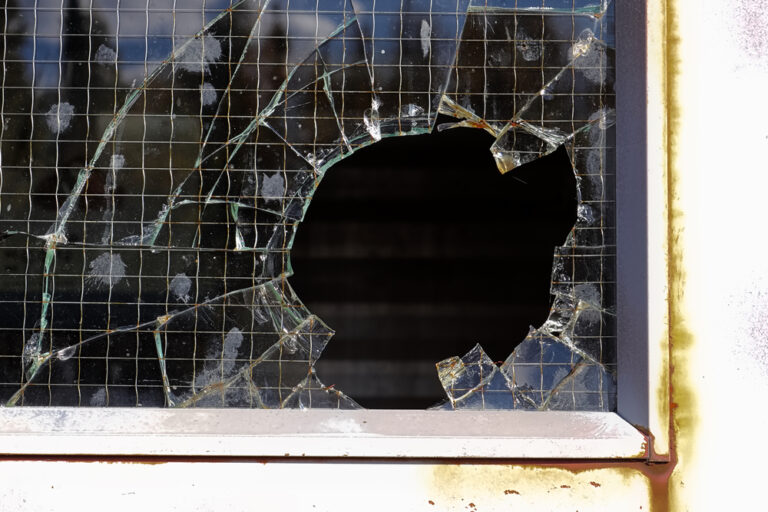Wired Glass Still a Misunderstood Product

What could you misinterpret from wired glass?
This article discusses how wired glass is a misunderstood product. For years, wired glass was the only fire rated glass product available. Codes have changed to restrict its use because it is fire protective and it is not a safety glass.
Wired Glass Still a Misunderstood Product
by Diana San Diego
Contrary to popular belief, wired glass has not been banned from use. Traditional wired glass can still be used in annealed glass applications– if it meets the wind and thermal load requirements– and in fire window assemblies that are not in hazardous locations. However, it is limited to 25 percent of the wall area. This size limitation applies to all fire protective glazing products.
Safety wired glass– although it looks like traditional wired– incorporated a safety film and meets both fire and Consumer Product Safety Commission impact safety requirements. It is suitable for use in any door, sidelite or other hazardous location where safety is a concern, as outlined in Chapter 24 of the International Building Code.
When specifying safety wired glass products, it is important to recognize that simply putting safety film on wired glass without prior testing and independent certification is not only inadequate, but a highly dangerous practice that violates code requirements. Not all films works; some can actually contribute to the spread of fire. The same concerns apply when putting safety film on existing wired glass in the field. It must be done under the guidelines of a certified field filming program to ensure that the new fire-rated safety wired glass meets the fire and impact safety requirements of the code.
The code history
Confusion in the marketplace continues to surround wired glass due in part to its code history. In 1997, the CPSC developed 16 CFR 1201 to protect people from injuries due to accidental impact with glazing in certain locations. This meant that glazing used in hazardous locations such as doors and sidelines had to meet a minimum Category I impact test that stipulated 150 foot-pounds of impact and limited glazing area to 9 square feet (1,296 square inches). A more stringent Category II impact test that stipulated 400 foot-pounds of impact also was established for glazing areas that exceeded that size, such as patio doors.
As the only fire-rated glazing product available product available at the time, traditional wired glass was granted a temporary exemption from meeting the CPSC standard. This exemption allowed wired glass manufactures to meet the lowest impact level of the ANSI Z97.1 standard stipulating 100 foot-pounds of impact.
This all changed in the 2003 International Building Code, when traditional wired glass lost its exemption from meeting safety glazing standards when used in educational and athletic facilities. In the 2004 IBC Supplement and the 2006 IBC, traditional wired glass was no longer exempt when used in any hazardous location for all new construction and in all types of occupancies. Replacement glazing up to 9 square feet (1,296 square inches) also had to meet the minimum CPSC Category I requirements. Furthermore, all glazing in gymnasiums or athletic facilities had to meet the more stringent Category II requirement.
While these code changes eliminated the use of traditional wired glass in areas where safety glazing is required, it did not constitute a complete ban on traditional wired glass.
Clear, non-wired fire and safety glazing alternatives
Clear, non-wired fire and safety-rated glazing options are alternative products that meet all of the fire and safety requirements of the code when fully certified, for applications where the institutional look of wire is undesirable. These options include specialty tempered glass, heat reflective specialty tempered glass, specialty fire protective glass 100-square-inch doorlites, filmed safety ceramics and laminated safety ceramics. Note, ceramic products must be filmed or laminated in order to be used in any hazardous locations, including doors and sidelites.
Clear fire-resistive products can be used in any fire-protective application and are required in any applications over 45 minutes, with the exception of 60-, 90- and 180-minute doors that might allowfire protective glass up to 100 square inches. Examples of fire resistive applications are one-hour and two-hour walls. Fire resistive glass use in these walls does not have any are limitations because of its ability to fully block radiant heat, an important characteristic that wire glass and other fire-protective products lack.
When in doubt, safety glaze
It is safe to assume that confusion as to where you can and cannot use traditional wired glass will continue to linger. We are fortunate to live in a time when a variety of fire- and safety-rated glazing products are readily available. As the old saying goes, “An ounce of prevention is worth a pound of cure.” When in doubt, use safety glazing products to avoid potential injuries and liabilities.
Source: Glass Magazine, June/July 2011